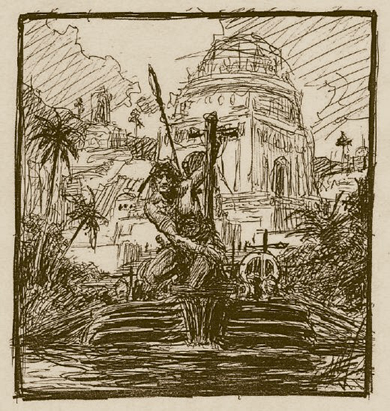 Twelve thousand years ago the mighty empire of Khokarsa stretched along the shores of Africa’s two great landlocked seas. According to what has been gathered from the legends of the Khokarsans, two thousand years prior their civilization was almost instantaneously delivered from the Old Stone Age to the Bronze Age by the intervention of a strange being known as Sahhindar, the Gray-Eyed Archer God. The Khokarsans regarded Sahhindar as the god of bronze, plants, and Time, and it was said that he was exiled from the land for stealing Time from his mother Kho, a fertility goddess and the chief deity of the Khokarsan people. Sahhindar was said to have introduced the Khokarsans to a variety of new plants, which, along with the animals and birds of the area, he taught them how to domesticate. The legends also state that Sahhindar instructed the Khokarsans in how to mine copper and tin, and how to craft these materials into bronze tools and weapons. As a result of the introduction of these and other wonders, the Khokarsan culture accelerated at a rate unprecedented in humanity’s history.
Twelve thousand years ago the mighty empire of Khokarsa stretched along the shores of Africa’s two great landlocked seas. According to what has been gathered from the legends of the Khokarsans, two thousand years prior their civilization was almost instantaneously delivered from the Old Stone Age to the Bronze Age by the intervention of a strange being known as Sahhindar, the Gray-Eyed Archer God. The Khokarsans regarded Sahhindar as the god of bronze, plants, and Time, and it was said that he was exiled from the land for stealing Time from his mother Kho, a fertility goddess and the chief deity of the Khokarsan people. Sahhindar was said to have introduced the Khokarsans to a variety of new plants, which, along with the animals and birds of the area, he taught them how to domesticate. The legends also state that Sahhindar instructed the Khokarsans in how to mine copper and tin, and how to craft these materials into bronze tools and weapons. As a result of the introduction of these and other wonders, the Khokarsan culture accelerated at a rate unprecedented in humanity’s history.
The capital of this grand civilization was on an island in the northern landlocked sea known as the Kemu (or Great Water). Here, on the island they called Khokarsa, the Khoklem (the People of Kho) came to settle after their long wanderings far to the north, in what was presumably Ice Age Europe. The Khoklem were joined by another people known as the Klemsuh (the Yellow People), who may have had their origins in distant Siberia among the ancestors of the Ainu people of Japan. At the apex of the Khokarsan civilization, the empire boasted thirty queendoms along the shores of the two seas, each ruled by a high priestess of Kho (who controlled the city’s judicial courts, the law-making, currency, religion, taxation, and commerce) and a king (who governed only the military, naval, and engineering sectors). The sungod Resu was second only to Kho in the Khokarsan pantheon, although the priests long sought to place their god above the Great Goddess. The resulting power struggle between the priestesses and the priests would endure for over eight hundred years.
The Khokarsan civilization did not, however, exist in a vacuum. Throughout its history, the tribes to the west and northwest had intermittent contact with the empire, with increased interaction between the cultures occurring in Khokarsa’s later period. The coasts of the two inland seas were inhabited by small groups of paranthropoids (ancestors of the sasquatch and yeti of today), neanderthaloids (Neaderthals), and half-neanderthaloids (human-Neanderthal hybrids). As the Khokarsan civilization advanced, all three of these groups were pushed southward, with the hybrids eventually settling in the hills and mountains northwest of the strait connecting the two seas, and the paranthropoids and neanderthaloids facing decreasing populations.
The great catastrophe that brought an end to Khokarsan civilization accounts for today’s paucity of information about the culture. Still, some ancestors of the Khokarsans went on to found new settlements after the disaster. One such site was the lost city of Kôr, discovered in 1873 by the world-renowned hunter Allan Quatermain, and rediscovered a few years later by Ludwig Horace Holly and Leo Vincey (the records of Quatermain’s and Holly’s visits to the ruins of Kôr are available, respectively, in the volumes She and Allan and She as edited by H. Rider Haggard).
A popular account of the Khokarsan heroes Hadon of Opar and Kwasin of Dythbeth, based on legends uncovered in the archaeological record, may be found in the omnibus Gods of Opar: Tales of Lost Khokarsa by Philip José Farmer and Christopher Paul Carey (Subterranean Press, 2012). For the full story of the time traveler who came to be known as Sahhindar, see Time’s Last Gift by Philip José Farmer (Titan Books, 2012). Those who wish to delve even deeper into the prehistoric civilization of Khokarsa are encouraged to seek out George Edward Challenger’s The Sahhindar Cult in Pre-Diluvian Khokarsa, although copies of this privately published monograph are admittedly hard to find.